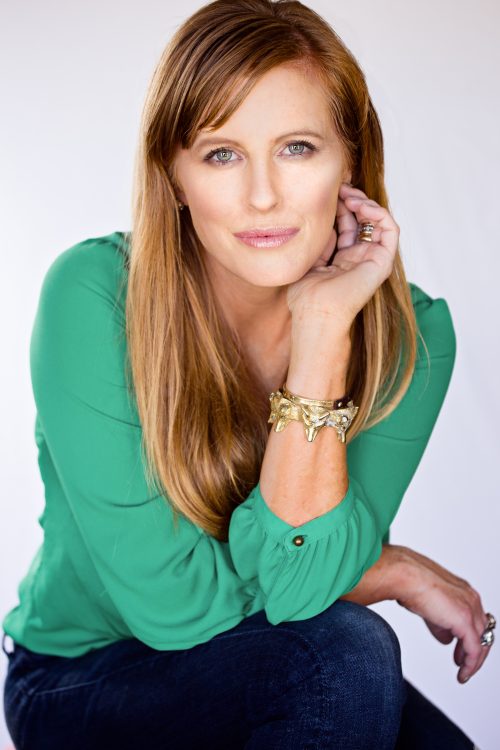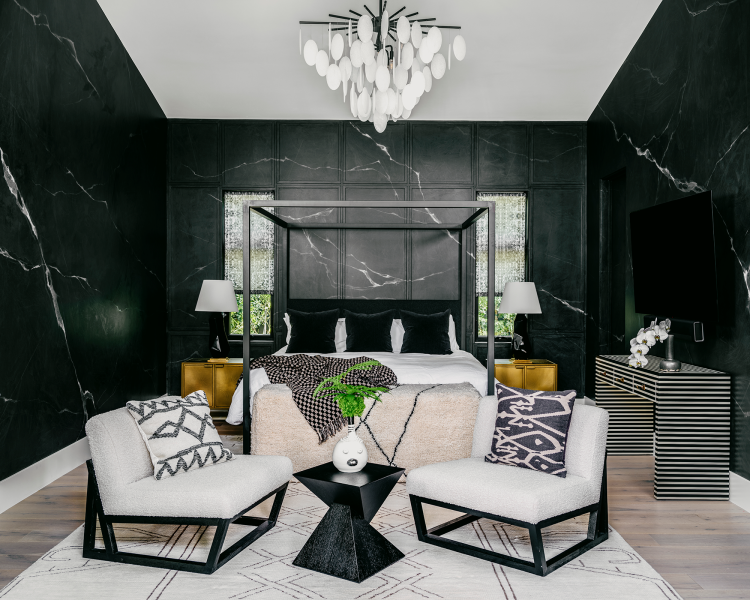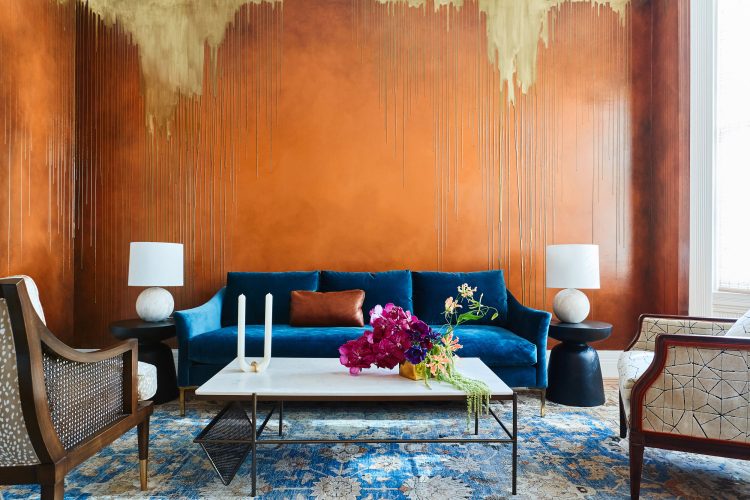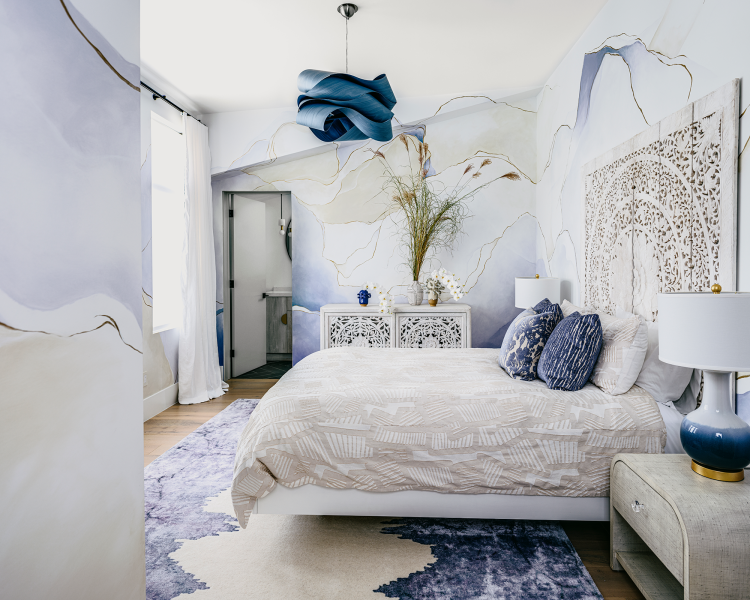Welcome to Artisan Spotlight, a column where we highlight Members’ favorite crafts and tradespeople, showing the work they bring to finished projects as well as the ways they view craftsmanship in a digitized world.
Caroline Lizarraga first realized the extent of her artistic talent in an exchange that feels straight out of the dream of a producer on HGTV’s Flea Market Flip. With an education in fashion and some formal art training, she’d always had “this calling to furniture,” she recalls. “One of the first pieces I bought, I got for $20 at a garage sale. I just had this vision of what is should look like—so I painted it. A designer I knew saw it and offered me $1,200 for it on the spot.” And a new career was born.
After some scrupulous saving, Caroline moved to Florence to study restoration. Upon returning stateside, she studied briefly under a decorative painter before breaking out on her own some two decades ago. Today, she works with a slew of top designers—like DLN Member Noz Nozawa, who recommended her in the Insiders Guide—to envision one-of-a-kind decorative treatments that add a unique layer of nuance to both commercial and residential projects. As the founder of a small, all-female creative studio based in a city known for its extreme wealth inequity, Caroline is passionate about championing craft as a career and removing the stigma around vocational education. We caught up with her by phone between installations to hear more about her work and practice.
This conversation had been edited for length and clarity.
You were fortunate to get to study in Italy—how important was that as a foundation to your work?
Well I think it’s always best to learn from a master. And in Italy, things are done very, very differently; time is not a conversation. You can take three years to restore a piece of furniture if that’s what it calls for. Here, we’re very much about the latest and greatest, but in Italy things are done the same way that they were done in the Renaissance.
I think it is really great to learn the classical things first, though. There’s a really beautiful Japanese lacquer technique called Negoro Nuri. And the concept comes from these red bowls that monks would eat out; their hands would hit the bowl over time and the black lacquer would start to start showing through. When I first started, that was one of the first pieces I ever did. It took me six or seven months to do a piece that was probably eight inches by 12 inches, because you wet sand in between and you do 17 coats of lacquer. I mean, who’s going to pay for that? Very few people. But I remember one of my first clients saw the box and she said, “Caroline, this is exquisite. Now figure out how to do this on my wall, cheaper and faster.” And that was the beginning of my brain starting to work that way: How do you take this amazing technique and bring it not to the masses, but you know, to a more accessible audience?
I’m obsessed with these old, decrepit finishes: I was invited in Italy to one of the Corsini princess’s houses. She was showing me around the property, and I said, “Oh my God the finish on that wall…” and she said she looked at me and she said, “Carolina, that is not a finish. That is called time.”
But I’m always studying that stuff—thinking about how I can bring that into an American market.
Besides travel, what have been some of your other most formative lessons?
I think color is so important. I think one of the best skills that was ever taught to me by my mentor was, she used to throw things in front of my face, like a piece of fabric, a second piece of fabric, a piece of leather, and maybe a piece of stone and she would say, “Find the perfect color for that.”
Do you feel like your style, or your portfolio of offerings, is always growing?
I want to change it every week if possible—and I think we are doing that. My goal is to never do the same thing twice.
I would say we’re known for certain things, but it takes a long time. There are people that are real risk takers and they have their own vision and work with a lot of us, but a lot of people have to see something before they can grab on to it.
I think restaurants are always like a very good theatrical stage for that: One of the things we’re known for is pouring resin down these walls. We did that for this restaurant, Robin, about eight years ago. And I mean, at first, people were just like, “this is insane.” I mean they loved it in the restaurant but wouldn’t think of it in a home. But now we’re getting calls to do it in these beautiful, fancy Pacific Heights homes. So I think anything you want to do just takes some pushing, and maye takes some time to catch on.
“I’m not interested in working with a designer once”
And how about your relationship with the designer and the clients?
I always want to try to find the voice of the designer, or the client; it’s not my voice. If you said to me, ‘Caroline, I want to reference, say, India,’ I would ask for your ideas, and then send you back some imagery, and the end product is this beautiful version of all of these ideas coming together.
More importantly than having our own style, I think, is knowing the style of the designer. I’m not interested in working with a designer once; you know, we do a powder room and that’s it. I become friends with the designers I work with.
Can you talk a little bit about how you find people who work for you? Are you looking for a certain style or do you train people once you hire them?
What’s most important is that we can teach what we need to teach. But we need someone who has a beautiful open attitude.
I think having people that have done some kind of set design or theater are really great because they get it, you know, that the show must go on!
I always want to keep my studio pretty small, like at an atelier level. But it’s a conversation that’s happening everywhere: If you’re good at your craft, you just cannot keep up with the demand.
Why do you think that is?
You know, a couple of people and I have been talking about starting a little group because I feel very strongly about this but I don’t have the wherewithal to do all this by myself. We want to start something for women that are underprivileged to teach these skills: craft skills, construction skills. Because you don’t go to school for construction, per se. And there’s a real stigma around trades like this. But there shouldn’t be!
Some of the most beautiful homes we work on, the ones making the most money are the electricians on the job. But there’s a stigma around it. And I think we need to change that. Take a chef, for example. 25 years ago, a chef was not a star and then the Food Network happened and now, a chef walks into the room and is treated like a god or goddess. And at the end of the day, they are not dissimilar to what we’re doing.
Explore more artisans on the Insiders Guide.



